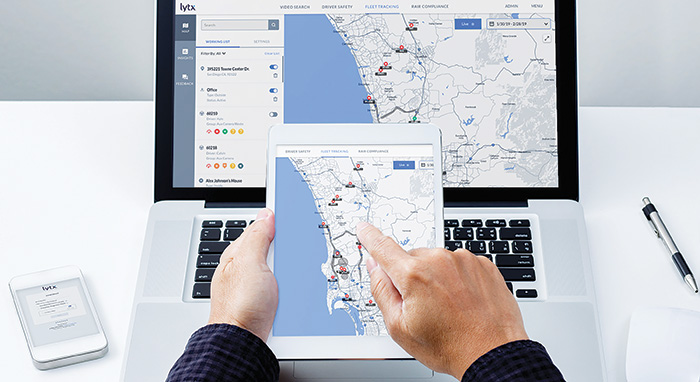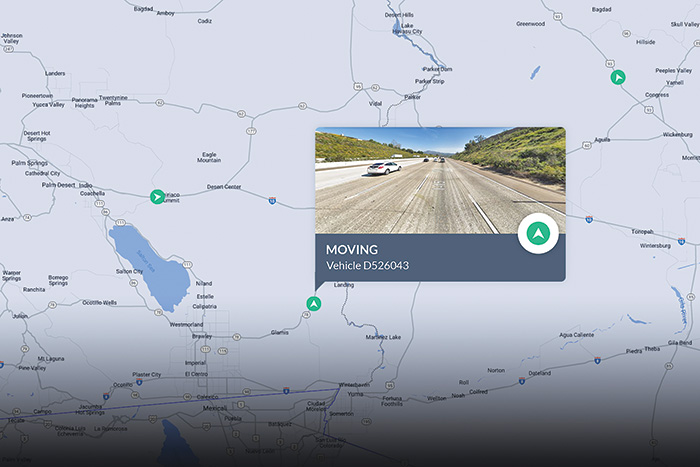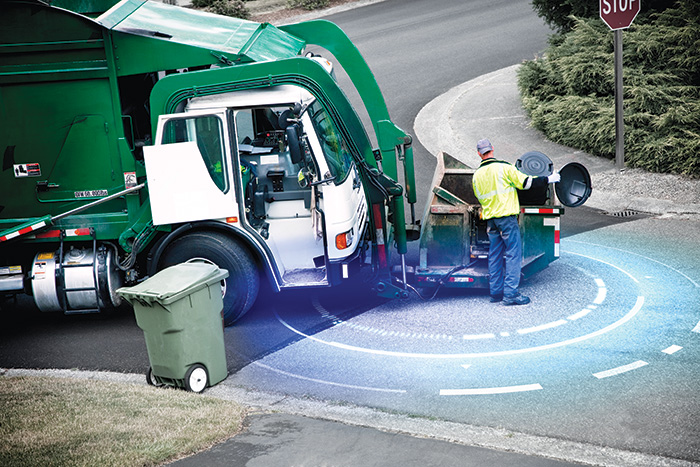Fleet tracking is becoming increasingly essential to the waste industry. With safety as a core value, the ability to continuously improve efficiencies and customer satisfaction can help companies of all shapes and sizes achieve overall operational excellence.
By Ryan Brandos
The waste industry has several unique challenges in its day-to-day operations. One of the most critical questions that comes up time and time again is simply, “Where are my vehicles right now?” Knowing where your vehicles and your service personnel are at any given time is a common question, and that is where state-of-the-art GPS fleet tracking solutions can help fleets that operate within the waste sector. “How far along their route is my driver?”, “Are they ahead of schedule or behind?”, “What is the current wait time at the landfill?”, “Do they have time to pick up some missed stops?”, “Did they visit this home or business?”—all of these questions and more can be solved for using robust GPS fleet tracking.
The addition of fleet tracking not only provides greater visibility for waste vehicles, but it can also immediately benefit day-to-day operations by saving time and money, in addition to improving safety and overall fleet performance.

Proactivity and Efficiency
GPS fleet tracking allows managers to view a live map of where all their vehicles are located in real time. In addition to providing live traffic conditions, speed, and direction, and whether a vehicle is stopped or idling, these features give dispatchers up-to-the-minute information to efficiently manage their fleet. Drivers no longer need to be interrupted during their route to share information on their status. If a driver encounters a problem and radios home, in just a couple of clicks, a dispatcher or manager can see where they are and, through a dash cam device, view a still image of the road ahead.
For increased visibility, higher-end dash cam devices allow for a live look from the front-facing camera to view an obstruction such as a locked gate, a damaged corral, or an unsafe operating environment. This saves not only time across the organization in handling different types of unexpected situations, but it also protects both the driver and organization from accusations and complaints of delayed and/or poor service.
Improvements in Customer Service and ETAs
If a customer calls in and wants to know where their 40-foot container delivery is, the customer service representative is typically only able to tell them that it is currently out for delivery and should be arriving sometime within a two- and three-hour time block. However, with access to video telematics, they can respond to the customer that the vehicle is currently on Highway 163 and looks to be about 10 miles from its destination.
Another example is a customer calling in to complain about a missed pickup. Fleet tracking can instantly show vehicle trips and routes, and can reveal important information, such as updates from a driver that they attempted pick up from that location 30 minutes ago and that it is likely that the customer did not make their dumpster available in time. This can quickly resolve customer complaints and save companies the time and money spent making return visits to a location.

Geofencing
Geofences are a powerful tool within enhanced fleet tracking solutions that allow for customizable functionality to better manage fleet operations. Drawing a geofence around a landfill with an entry alert can let companies know that a driver has entered the area. An exit alert can also be set to confirm when a driver has resumed their planned route. Over time, the average duration that a driver is detained in the landfill can help determine the more congested times and days of the week. This knowledge can allow fleets to adjust their routes accordingly in order to achieve higher efficiency. Additionally, companies can tap into a video telematics companies’ network of waste vehicles’ data to better understand if their drivers are taking longer than normal at a particular landfill.
Geofences can also be used to see when drivers leave or return to the yard, to make sure they are departing on time or just to know that they have returned safely to home base. In a tracking application, geofences are custom shapes that can be drawn at such a scale as to know which side of the street a vehicle is currently servicing. Geofencing is a powerful tool to better understand how fleets operate and it is an efficient way to get real time information about key milestones with the daily operation of waste vehicles.
Idle Time Management
One of the more costly issues involving fleets in all industries is fuel loss due to unnecessary idling. Fleet tracking can allow for proactive idle monitoring by alerting managers when a vehicle has been idle for a set amount of time, gauging fuel consumed while idling, and determining whether the vehicle is in power takeoff mode. This distinction means nuanced data around the practice of idling gives organizations a more complete picture of how each of their vehicles is operating.
Reducing fuel lost to idling even by a modest 10 to 20 percent can save an organization significant operating costs. In addition to the savings, reductions in idle times can also have a positive impact on the environment. According to Lytx’s 2023 “State of the Data” report, as a result of a 16 percent drop in idle times in 2022, Lytx clients were able to prevent more than 90 million pounds of CO2 emissions and more than $24 million in wasted fuel.
Route Management and Weather
Leveraging the power of large driving databases, video safety and video telematics companies can provide useful insights, helping customers uncover the riskiest locations in their operating areas. If an intersection with particularly poor visibility is currently part of a driver’s route, with a detailed risk map, organizations can route around these ‘hotspots’ and reduce the intrinsic risk to which their fleet is exposed.
Another example is how inclement weather can affect the conditions on the roadways and impact driver safety. With real-time weather alerting, drivers can receive NOAA alerts, and managers can view still pictures along routes to assess road conditions collected from devices in the field. Dispatchers and call centers can also use weather information about the operational environment to assess the safety of the conditions before sending a vehicle out of the yard.

Claims Mitigation
Claims costs are rising in every industry, and best practices to mitigate those claims are becoming more important with each passing year. One of the ways fleet tracking can help mitigate claims arising from customer complaints of vehicle or property damage is to simply know when and where the vehicle was located. Callers may claim that a waste vehicle damaged their landscaping or ran them into the shoulder of the highway. Having the ability to quickly and definitively assess the veracity of these accusations reduces the resources spent on frivolous claims of damages. These savings quickly add up when the combination of video and telematics reveals the circumstances of an incident with less investigation. Even claims that are true and valid can be resolved more quickly, which also saves money, time, and resources.1
Operational Excellence
Fleet tracking is becoming increasingly essential to the waste industry as it provides Operations, Fleet, Logistics, Dispatch, and Customer Service departments with increased visibility and the crucial information to efficiently manage their business, while also reducing risk. With safety as a core value, the ability to continuously improve efficiencies and customer satisfaction can help companies of all shapes and sizes achieve overall operational excellence. | WA
Ryan Brandos is a Senior Key Account Manager and has been with Lytx since 2013. He began by providing dedicated support to Waste Management’s DriveCam Program, and later spent several years as a Research Data Analyst performing custom analytics for both customers and transportation industry events and conferences. Now in an Enterprise Sales role, Ryan continues to be one of Lytx’s ambassadors for the depth of Lytx data to many large-scale enterprise fleets, with a particular focus on the waste industry. For more information, visit www.lytx.com.
Note
In 2022, thanks to Lytx’s video safety and video telematics systems, clients achieved an estimated $1.4 billion savings on claims, including workers compensation and insurance claims.
